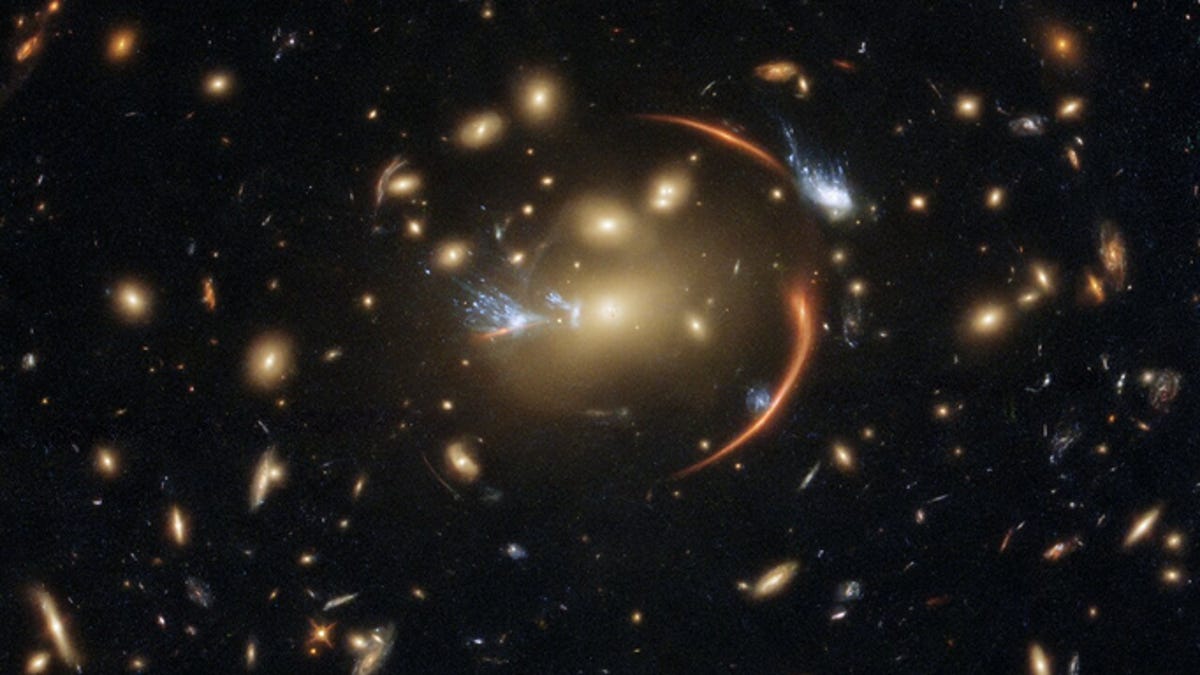NASA's Hubble telescope helps scientists solve mystery of dead galaxies
Why did some galaxies from the early universe suddenly stop making stars? Astronomers look back in time to find out.

The slumbering giant galaxy at the center of this image is 10 billion light-years away.
As mere mortals, we yearn to travel back in time -- an obsession nourished by iconic contraptions like Marty McFly's DeLorean, Hermione Granger's time turner and Doctor Who's police box. Often forgotten, however, are the real-life astronomers who kind of already do it.
Recently, one such research team tapped time travel to solve a space mystery from billions of years ago using a unique combination of super sensitive telescopes: Why did some of the early universe's galaxies strangely stop popping out stars and become inactive, or quiescent?
Galaxies are thought to be at the pinnacle of their star manufacturing potential at this moment in time, so it's especially puzzling when we discover any that are dormant. Right now, they should be making more stars than ever.
"The most massive galaxies in our universe formed incredibly early, just after the Big Bang happened," Kate Whitaker, a professor of astronomy at University of Massachusetts-Amherst and lead author of a new study, said in a statement. "But for some reason, they have shut down. They're no longer forming new stars."
It turns out, some old galaxies merely ran low on star fuel, or cold gas, early on in their lifetimes. The results of the group's study were published Wednesday in the journal Nature and could rewrite our knowledge of how the universe evolved.
But hold on, you're probably still on that bit about astronomers going back in time. If they can swing that, why didn't they show up to Stephen Hawking's famous time-traveler-only dinner party?
You might have heard the term "light-year," which refers to the distance light whizzes along in one Earth year. We need this term as a measurement because light doesn't travel instantaneously. Of course, turning on your bedroom lamp leads to near-immediate brightness, but if someone turned on a flashlight while standing on the moon, about 238,900 miles (384,472 kilometers) away, its beam wouldn't reach us for over a second.
That means moonlight has about a one-second lag for us Earthlings. In effect, when we glance at the moon, we're seeing everything one second after it happens. We're sort of looking back in time.
Astronomers scale that concept up by the billions. Using powerful telescopes as time machines, they look into deep space -- like, billions of light-years away. For this study that mined the mystery of prematurely "dying" galaxies, for instance, the team looked at six cosmic bodies 10 billion to 12 billion light-years away in the universe.
So, it took 10 billion to 12 billion years for any illumination within the studied area to reach their telescope lenses. That means the astronomers were looking back in time far enough to watch the moments soon after the Big Bang -- which occurred about 14 billion years ago -- unfold in real-time.
Lo and behold, that's how they solved the cosmic puzzle. The researchers say the galaxies either burned through their cold gas supply too quickly or are blocked from replenishment.
More specifically, Whitaker and fellow researchers demystified the issue by using a mixture of powerful telescopes: the Hubble Space Telescope and the Atacama Large Millimeter/submillimeter Array, or ALMA. The Hubble Space Telescope is sensitive to light across the spectrum -- even the type humans can't see.
And as if time travel wasn't fantastical enough, the team took advantage of another tool called gravitational lensing to enhance the light collected. Basically, the lens' viewpoint traveled along a line decorated by hundreds of other galaxy clusters.
Gravitational pulls of those galaxies were strong enough to warp beams of light coming from the team's six galaxies of interest, stretching them while they traveled to Earth. That helped shed light -- no pun intended -- on juicy details that would have otherwise been missed within the galaxies.
ALMA, on the other hand, used those details to look for levels of the cold gas, or star fuel, needed by galaxies to make stellar bodies. "There was copious cold gas in the early universe, so these galaxies, from 12 billion years ago, should have plenty left in the fuel tank," Whitaker said.
Now we know -- thanks to the closest we've come to time travel -- those tanks have been empty.

